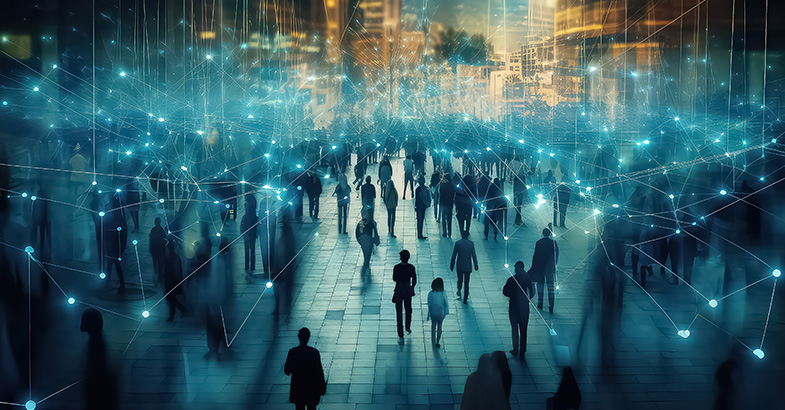
In a post-Covid world dominated by social distancing, public gatherings have become but a distant memory. Limits on the number of people attending weddings, funerals, and other social engagements make it easier to manage the number of people. As was in the past, in the post-covid world too, large public gatherings have returned. Exciting as it sounds, it will be challenging too. A large public event presents the threat of attacks or foot traffic congestion. In such a scenario, Crowd Management Analytics assume great importance. Real time data collection is of utmost importance to efficiently monitor, direct, and manage large groups of people.
Tools of AI and IOTs can be deployed to manage, divert, and organise crowds. Unmanned Aerial Vehicles (UAVs) to Mobile Crowd Sensing and Computing (MCSC) have offered solutions at large gatherings such as the Hajj. Smart crowd-monitoring and inter-connected intelligent technologies can manage large crowds through detection and ultimately prevention of potential threats of bottlenecks. This system can help law enforcement agencies or event organisers track the location of physical barriers, active street closures and manage and optimise traffic flow through various venues. The resources can thus be redistributed by creating real-time maps of attendees and thereby optimising their safety. (https://www.coolfiresolutions.com/blog/crowd-control-smart-crowd-monitoring/)
Data Analytics offers solutions to crowd management. Initially, raw data from cyber-physical world is collected and processed for treatment of imperfections. The data is then submitted for integration, storage and processing for greater computational optimisation. To get additional insights, mining, analysis and visualisation of the data are imperative. (https://www.researchgate.net/publication/332775847_Crowd_Management_A_New_Challenge_for_Urban_Big_Data_Analytics)
AI along with smart cameras with facial recognition software help local authorities identify suspicious individuals and abnormal activity. Face detection, attentiveness, emotion recognition and unique people count alert authorities to any suspicious activity by comparing real-time video data against stored data of “normal movements and expressions”. Deep Learning is used for emotion/ attention detection. Infrared cameras track crowd densities and provide law enforcement officers with valuable insights to prevent harm from threatening situations.
Crowd management companies in China have considerable resource access to voices, faces, and other biometric data in vast number of employees and visitors. Newer technologies make it possible to match images, voice, and GPS location with different types of information when accessed through cell phones. AI on these combined data can improve law enforcement and national security. Through its “Sharp Eyes” programme, Chinese law enforcement matches video images, social media activity, online purchases, travel records, and personal identity into a “police cloud.” This integrated database enables authorities to keep track of criminals, potential law breakers, and terrorists. China has become the world’s leading AI-powered surveillance state. (https://www.brookings.edu/research/how-artificial-intelligence-is-transforming-the-world/)
Orlando International Airport uses lidar-based, real-time crowd analytics technology to maximise safety at its terminals during the Covid-19 pandemic. The Indoor Lab is a foot-traffic monitoring specialist. It has partnered with lidar company Cepton. Together, they have found a solution that uses Cepton’s Helius smart lidar system to provide intelligent, anonymised, 3D tracking of people across large over-lapping areas. (www.smartcitiesworld.net/news/news/orlando-international-airport-uses-lidar-based-crowd-a)
Not only in crowd management, analytics and AI can play a major role in preparing the organisers/ authorities in crowd control. Stampedes at religious places, stadiums, political rallies can be thus avoided.
Closer home in India, managing crowds at temples, during festivals such as Durga Puja and at the time of Ganesh Visarjan is a challenging and mammoth task for the authorities. Big Data Analytics can help streamline darshan and long queues for more organised participation by the devotees at such congregations and at places of worship. For instance, at Tirumala Tirupati Devasthanam, biometric technology is extensively used. A prepaid smart card is issued to devotees for a seamless and cashless transaction. Devotees can use e-TTD audio and video from anywhere in the world via their mobile phone. TTD is now piloting a virtual queue system to reduce response time for slotted seva darshans. It is planning a big data centre in Tirupati with an investment of INR 15 crore, with which services will be further improved and secured.
“The aim is to address key strategic mandates such as video analytics, monitoring visibility, proactive interventions, real time processing by integrating with the command-and-control centre and video management system on a turnkey basis,” says Gopinath Jatti, IPS, chief vigilance and security officer, TTD. (https://timesofindia.indiatimes.com/city/vijayawada/ttd-to-enhance-temple-surveillance-with-rs-16cr-project/articleshow/67679029.cms) While AI and big data can provide solutions for crowd management, the downside is the ethical aspect of loss of privacy and constant monitoring without consent. The real question remains: is loss of privacy and freedom a worthwhile price for added public safety?

